- Clone
- 162.1 (See other available formats)
- Regulatory Status
- RUO
- Other Names
- CD2 like receptor activating cytotoxic cells, CD319, CS1, 19A24, SLAMF7
- Isotype
- Mouse IgG2b, κ
- Barcode Sequence
- AGTATGCCATGTCTT
| Cat # | Size | Price | Quantity Check Availability | ||
|---|---|---|---|---|---|
| 331821 | 10 µg | $369.00 | |||
CD319 is a single-pass type l transmembrane glycoprotein, expressed on NK cells, subsets of mature dendritic cells, activated B cells, and cytotoxic lymphocytes, but not in promyelocytic, B or T cell lines. Expression is highest in the spleen, lymph nodes, and peripheral blood leukocytes, and lowest in bone marrow. Additionally, it is expressed in the small intestine, stomach, appendix, lung, and trachea. CD319 is tyrosine phosphorylated in activated NK cells and is associated with 19 and 39 kD proteins. CD319 has homology with the CD2 family of receptors within the Ig superfamily. Some of the CD2 members stimulate cytotoxicity through the CD319 associated protein.
Product Details
- Verified Reactivity
- Human
- Reported Reactivity
- Cynomolgus
- Antibody Type
- Monoclonal
- Host Species
- Mouse
- Immunogen
- CRACC-Human IgG1 fusion protein
- Formulation
- Phosphate-buffered solution, pH 7.2, containing 0.09% sodium azide and EDTA
- Preparation
- The antibody was purified by chromatography and conjugated with TotalSeq™-A oligomer under optimal conditions.
- Concentration
- 0.5 mg/ml
- Storage & Handling
- The antibody solution should be stored undiluted between 2°C and 8°C. Do not freeze.
- Application
-
PG - Quality tested
- Recommended Usage
-
Each lot of this antibody is quality control tested by immunofluorescent staining with flow cytometric analysis and the oligomer sequence is confirmed by sequencing. TotalSeq™-A antibodies are compatible with 10x Genomics Single Cell Gene Expression Solutions.
To maximize performance, it is strongly recommended that the reagent be titrated for each application, and that you centrifuge the antibody dilution before adding to the cells at 14,000xg at 2 - 8°C for 10 minutes. Carefully pipette out the liquid avoiding the bottom of the tube and add to the cell suspension. For Proteogenomics analysis, the suggested starting amount of this reagent for titration is ≤ 1.0 µg per million cells in 100 µL volume. Refer to the corresponding TotalSeq™ protocol for specific staining instructions.
Buyer is solely responsible for determining whether Buyer has all intellectual property rights that are necessary for Buyer's intended uses of the BioLegend TotalSeq™ products. For example, for any technology platform Buyer uses with TotalSeq™, it is Buyer's sole responsibility to determine whether it has all necessary third party intellectual property rights to use that platform and TotalSeq™ with that platform. - Additional Product Notes
-
TotalSeq™ reagents are designed to profile protein levels at a single cell level following an optimized protocol similar to the CITE-seq workflow. A compatible single cell device (e.g. 10x Genomics Chromium System and Reagents) and sequencer (e.g. Illumina analyzers) are required. Please contact technical support for more information, or visit biolegend.com/totalseq.
The barcode flanking sequences are CCTTGGCACCCGAGAATTCCA (PCR handle), and BAAAAAAAAAAAAAAAAAAAAAAAAAAAAAA*A*A (capture sequence). B represents either C, G, or T, and * indicates a phosphorothioated bond, to prevent nuclease degradation.
View more applications data for this product in our Scientific Poster Library. -
Application References
(PubMed link indicates BioLegend citation) -
- Bouchon A, et al. 2001. J. Immunol. 167:551721.
- Tassi I and Colonna M. 2005. J. Immunol. 175:79968002.
- Veillette A. 2006. Immunol. Rev. 214:2234.
- Product Citations
-
- RRID
-
AB_2800872 (BioLegend Cat. No. 331821)
Antigen Details
- Structure
- Ig superfamily, 66 kD.
- Distribution
-
NK cells, subsets of mature dendritic cells, activated B cells, cytotoxic lymphocytes but not in promyelocytic, B or T cell lines.
- Function
- Regulates T cell and NK cell functions.
- Cell Type
- B cells, Dendritic cells, Lymphocytes, NK cells, Tregs
- Biology Area
- Immunology
- Molecular Family
- CD Molecules
- Antigen References
-
1. Bouchon A, et al. 2001. J. Immunol. 167:551721.
2. Tassi I and Colonna M. 2005. J. Immunol. 175:79968002.
3. Veillette A. 2006. Immunol. Rev. 214:2234. - Gene ID
- 57823 View all products for this Gene ID
- UniProt
- View information about CD319 on UniProt.org
Other Formats
View All CD319 Reagents Request Custom Conjugation| Description | Clone | Applications |
|---|---|---|
| Purified anti-human CD319 (CRACC) | 162.1 | FC,IP |
| PE anti-human CD319 (CRACC) | 162.1 | FC |
| PerCP/Cyanine5.5 anti-human CD319 (CRACC) | 162.1 | FC |
| APC anti-human CD319 (CRACC) | 162.1 | FC |
| PE/Dazzle™ 594 anti-human CD319 (CRACC) | 162.1 | FC |
| PE/Cyanine7 anti-human CD319 (CRACC) | 162.1 | FC |
| FITC anti-human CD319 (CRACC) | 162.1 | FC |
| Alexa Fluor® 647 anti-human CD319 (CRACC) | 162.1 | FC |
| TotalSeq™-A0830 anti-human CD319 (CRACC) | 162.1 | PG |
| TotalSeq™-C0830 anti-human CD319 (CRACC) | 162.1 | PG |
| TotalSeq™-B0830 anti-human CD319 (CRACC) | 162.1 | PG |
| PerCP/Fire™ 806 anti-human CD319 (CRACC) | 162.1 | FC |
Compare Data Across All Formats
This data display is provided for general comparisons between formats.
Your actual data may vary due to variations in samples, target cells, instruments and their settings, staining conditions, and other factors.
If you need assistance with selecting the best format contact our expert technical support team.
-
Purified anti-human CD319 (CRACC)
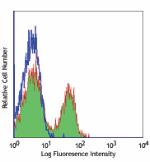
Human peripheral blood lymphocytes stained with purified 162... -
PE anti-human CD319 (CRACC)
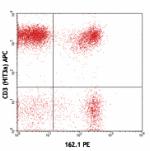
Human peripheral blood lymphocytes stained with CD3 (HIT3a) ... -
PerCP/Cyanine5.5 anti-human CD319 (CRACC)

Human peripheral blood lymphocytes were stained with CD3 FIT... -
APC anti-human CD319 (CRACC)
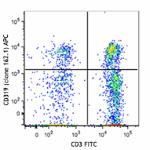
Human peripheral blood lymphocytes were stained with CD3 FIT... 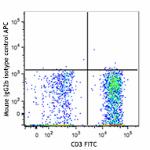
-
PE/Dazzle™ 594 anti-human CD319 (CRACC)
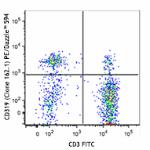
Human peripheral blood lymphocytes were stained with CD3 FIT... 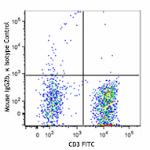
-
PE/Cyanine7 anti-human CD319 (CRACC)

Human peripheral blood lymphocytes were stained with CD3 FIT... -
FITC anti-human CD319 (CRACC)
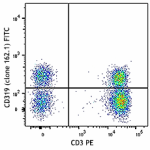
Human peripheral blood lymphocytes were stained with CD3 PE ... 
-
Alexa Fluor® 647 anti-human CD319 (CRACC)
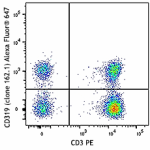
Human peripheral blood lymphocytes were stained with CD3 PE ... 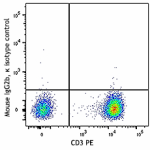
-
TotalSeq™-A0830 anti-human CD319 (CRACC)
-
TotalSeq™-C0830 anti-human CD319 (CRACC)
-
TotalSeq™-B0830 anti-human CD319 (CRACC)
-
PerCP/Fire™ 806 anti-human CD319 (CRACC)

Human peripheral blood lymphocytes were stained with anti-hu...
